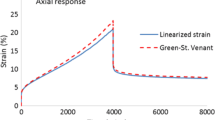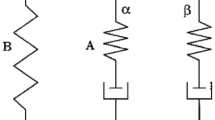Abstract
A thermodynamically consistent framework for describing the response of materials undergoing deformation-induced degradation is developed and applied to a particular biodegradable polymer system. In the current case, energy is dissipated through the mechanism of hydrolytic degradation and its effects are incorporated in the constitutive model by appropriately stipulating the forms for the rate of dissipation and for the degradation-dependent Helmholtz potential which changes with the extent of the degradation of the material. When degradation does not occur, the response of the material follows the response of a power-law generalized neo-Hookean material that fits the response of the non-degraded poly(l-lactic acid) under uniaxial extension. We study the inflation and extension of a degrading cylindrical annulus and the influence of the deformation on the mechanism of degradation and its consequent mechanical response. Depreciation of mechanical properties due to degradation confers time-dependent characteristics to the response of the biodegradable material: the material creeps when subjected to constant loads and stresses necessary to keep a fixed deformation relax.
Similar content being viewed by others
References
Baek S, Srinivasa AR (2004) Diffusion of a fluid through an elastic solid undergoing large deformation. Int J Nonlinear Mech 39: 201–218
Booth C (1963) The mechanical degradation of polymers. Polymer 4: 471–478
Burkersroda Fv, Schedl L, Gopferich A (2002) Why degradable polymers undergo surface erosion or bulk erosion. Biomaterials 23: 4221–4231
Chu CC (1985) Strain-accelerated hydrolytic degradation of synthetic absorbable sutures. In: Hall CW (eds) Surgical research recent developments: proceedings of the first annual scientific session of the Academy of Surgical Research, 1st edn. Pergamon Press, San Antonio, pp 111–115
Colombo A, Karvouni E (2000) Biodegradable stents: fulfilling the mission and stepping away. Circulation 102: 371–373
Garlotta D (2001) A literature review of poly(lactic acid). J Polym Environ 9: 63–84
Gopferich A (1997) Mechanisms of polymer degradation and elimination. In: Domb AJ, Kost J, Wiseman DM (eds) Handbook of biodegradable polymers, 1st edn. Harwood, Australia, pp 451–471
Harmon DJ, Jacobs HL (1966) Degradation of natural rubber during mill mastication. J Appl Polym Sci 10: 253–257
Hawkins WL (1984) Polymer degradation. Springer, Berlin
Kannan K, Rajagopal KR (2005) Simulation of fiber spinning including flow-induced crystallization. J Rheol 49: 683–703
Knowles JK (1977) Finite anti-plane shear field near tip of a crack for a class of incompressible elastic solids. Int J Fract 13: 611–639
Langer R (1998) Drug delivery and targeting. Nature 392: 5–10
Laufman H, Rubel T (1977) Synthetic absorable sutures. Surg Gynecol Obstet 145: 597–608
Levenberg S, Langer R (2004) Advances in tissue engineering. In: Schatten GP (eds) Current topics in developmental biology. 1st edn. Elsevier Academic, San Diego, pp 113–134
Lunt J (1998) Large-scale production, properties and commercial applications of polylactic acid polymers. Polym Degrad Stabil 59: 145–152
Miller ND, Williams DF (1984) The invivo and invitro degradation of poly(glycolic acid) suture material as a function of applied strain. Biomaterials 5: 365–368
Ottenbrite RM, Albertsson AC, Scott G (1992) Discussion on degradation terminology. In: Vert M, Feijen J, Albertsson AC, Scott G, Chiellini E (eds) Biodegradable polymers and plastics. 1st edn. The Royal Society of Chemisty, Cambridge, pp 73–92
Pietrzak WS, Sarver DR, Verstynen ML (1997) Bioabsorbable polymer science for the practicing surgeon. J Craniofac Surg 8: 87–91
Rajagopal KR (2003) Diffusion through polymeric solids undergoing large deformations. Mater Sci Technol 19: 1175–1180
Rajagopal KR, Srinivasa AR (2004) On the thermomechanics of materials that have multiple natural configurations—part i: Viscoelasticity and classical plasticity. Z Agnew Math Phys 55: 861–893
Rajagopal KR, Wineman A (1980) On constitutive-equations for branching of response with selectivity. Int J Nonlinear Mech 15: 83–91
Rajagopal KR, Wineman AS (1992) A constitutive equation for nonlinear solids which undergo deformation induced microstructural changes. Int J Plast 8: 385–395
Rajagopal KR, Srinivasa AR, Wineman AS (2007) On the shear and bending of a degrading polymer beam. Int J Plast 23: 1618–1636
Rajagopal KR, Wineman AS (2004) A note on viscoelastic materials that can age. Int J Nonlinear Mech 39: 1547–1554
Rao IJ, Rajagopal KR (2007) The status of the k-bkz model within the framework of materials with multiple natural configurations. J Non-Newton Fluid 141: 79–84
Schnabel W (1981) Polymer degradation. Macmillan, New York
Soares JS (2008) Constitutive modeling of biodegradable polymers for application in endovascular stents. PhD Dissertation, Texas A&M University, College Station, TX
Soares JS (2009) Diffusion of a fluid through a spherical elastic solid undergoing large deformations. Int J Eng Sci 47: 50–63
Soares JS, Moore JE, Rajagopal KR (2008) Constitutive framework for biodegradable polymers with applications to biodegradable stents. ASAIO J 54: 295–301
Tammela TL, Talja M (2003) Biodegradable urethral stents. BJU Int 92: 843–850
Weir NA, Buchanan FJ, Orr JF et al (2004) Processing, annealing and sterilisation of poly-l-lactide. Biomaterials 25: 3939–3949
Wiggins MJ, Anderson JM, Hiltner A (2003) Effect of strain and strain rate on fatigue-accelerated biodegradation of polyurethane. J Biomed Mater Res A 66: 463–475
Wiggins MJ, MacEwan M, Anderson JM et al (2004) Effect of soft-segment chemistry on polyurethane biostability during in vitro fatigue loading. J Biomed Mater Res A 68: 668–683
Wineman A (2001) Torsion of an elastomeric cylinder undergoing microstructural changes. J Elast 62: 217–237
Yu JFS, Zakin JL, Patterson GK (1979) Mechanical degradation of high molecular-weight polymers in dilute-solution. J Appl Polym Sci 23: 2493–2512
Zhong SP, Doherty PJ, Williams DF (1993) The effect of applied strain on the degradation of absorbable suture in vitro. Clin Mater 14: 183–189
Author information
Authors and Affiliations
Corresponding author
Rights and permissions
About this article
Cite this article
Soares, J.S., Rajagopal, K.R. & Moore, J.E. Deformation-induced hydrolysis of a degradable polymeric cylindrical annulus. Biomech Model Mechanobiol 9, 177–186 (2010). https://doi.org/10.1007/s10237-009-0168-z
Received:
Accepted:
Published:
Issue Date:
DOI: https://doi.org/10.1007/s10237-009-0168-z




